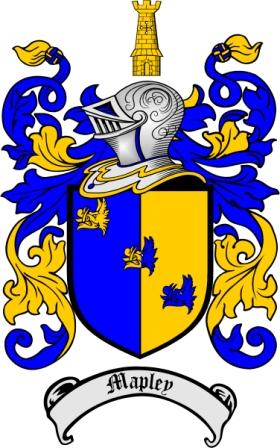| |
|
For updating Mapley family records...
|
|
==> David Mapley,
37 Bayne Street
Norwalk, CT 06851, USA |
|  |
| E-mail: |
|
david@mapley.org |
|
|
Railways - Early Days
The advent of a national railway network created employment for the Mapley generations and
also led to migration away from Buckinghamshire.
An Act of Parliament in 1833 authorised the building of the London to Birmingham railway
and a depot was required halfway as it was considered unsafe for engines to run more
than 50 miles without being examined. Wolverton was ideally placed to be the halfway mark
especially with the Grand Union Canal nearby offering wharfing facilities and the chosen
direction for the line crossing the canal close by. The London & Birmingham Railway Company
founded Wolverton in 1838.
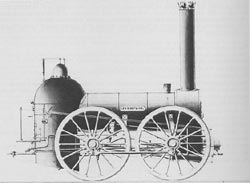
Bury Engine, 1837
| |
Wolverton was the first purpose built Railway town on a green-field site, where everything had
to be built from scratch. Workers moved there from other areas. Their new homes and employment
were provided by The Railway Company. The Company provided education and leisure facilities
and laid out the Town on a classic grid system. Conditions were considered good and allotments
were an essential part of The Town. The early locomotive repair depot also continued to expand
until Wolverton Works filled a large area. It became The Southern Headquarters of the LNWR Railway
and the famous Victorian engineer McConnell designed "The Bloomer" locomotive there.
return to the top...
|
Wolverton Locomotive Works
Wolverton railway works was established in Wolverton by the London and Birmingham Railway
Company in the 1830's at the midpoint of the 112 mile-long route from London to Birmingham. The
Victorian era new towns of Wolverton and New Bradwell were built to house the workers and
service the works. The older towns of Stony Stratford, Great Linford and Newport Pagnell grew
substantially too, being joined to it by a tramway and railway,
respectively. The trams were also hauled by steam locomotives: the tram cars were certainly
the largest ever in the UK and possibly the world.
|
In 1846 the line became part of the London and North Western Railway and the Works grew in
importance. Between 1849 and 1862, three types of 2-2-2 express engines, the 0-6-0 'Wolverton
Goods' engine, and the 0-4-2 'Wolverton Tank' engine, were built. About 180 locomotives were
built to the Wolverton design, mostly by subcontractors, just 12 were built at Wolverton. In 1877
a decision was taken to concentrate locomotive work at Crewe, leaving Wolverton to become, in
time, the largest carriage works in Great Britain — and a major employer in the area for many years.
| |
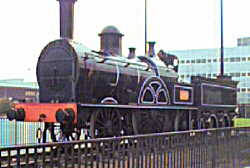
The Bloomer Engine, 1849
|
In 1901, Wolverton was the first railway works to use electricity for lighting and driving
machinery throughout. A new royal train was built in 1903. In 1923, when the LNWR merged into
the LMS, wagon building was introduced. Such work continued after nationalisation but, in 1962,
Wolverton ceased production of new stock.
During the 1914-18 war the Works altered carriages to be used as ambulance trains for home and
abroad. Their war work also included working for the Ministry of Munitions. During and between
the wars all sorts of things were made at the Works and once again the 1939-45 conflict meant that
ambulance trains were in demand together with armoured vehicles, mobile kitchens, wings for
Hawker Typhoons and Horsa gliders for the D-Day airborne assault, assault boats and, unusually, Whitley bombers
were sent for repair.
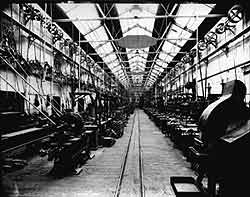
Fitting Shop
|
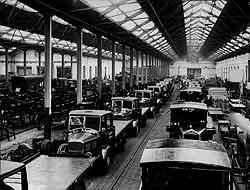
Liftng Shop
|
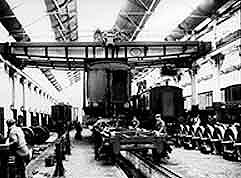
Paint Shop
|
In addition work continued providing the Royal Train. Queen Victoria's 1869 saloon, comprising
two six-wheelers joined by the first bellows gangway in Europe, is in the National Railway Museum
in York. Further Royal coaches were built in 1903 for King Edward VII and in 1961 for Queen Elizabeth II.
The most recent Royal train was fitted out at Wolverton in 1977.
return to the top...
Newport Pagnell & Great Linford
In 1817 a branch of the Grand Junction Canal was cut from the main line at Great Linford to
Newport Pagnell. The total length was one and a quarter miles rising through seven locks. The first
suggestion of building a railway line to Newport Pagnell came in 1845 but the venture failed to
attract sufficient capital.
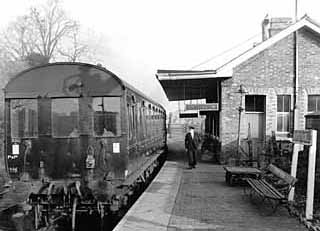
Newport Pagnell railway station, May 1967
| |
The Newport Pagnell Railway Act was passed in 1863 and the following year the Newport Pagnell Railway
Company bought the short branch canal with the intention of using the route for their new
railway line into Newport Pagnell. The line did exactly follow the canal route which hugged
the contours of the surrounding land. The intention was to continue the line on to the Market
town of Olney and powers were granted for this extension in 1865 with a further extension to
join the Northampton-Peterborough line at Wellingborough. The extensions beyond Newport Pagnell were never built with powers lapsing in 1871 although some work had been undertaken.
|
|
The line was complete by 30th September 1865 when the first locomotive traversed the line. The
next year the railway opened for goods, cattle and parcel traffic and on 2nd September 1867, there
was the ceremonial opening of the line for passengers (known as the "Newport Nobby"). There were
two intermediate stations
at Bradwell and Linford (the station was originally called Linford, the Great was added in March 1884).
The lines main regular passengers were employees of the Railway Works at Wolverton. In 1875 the
line was taken over by the London & North Western Railway who had provided the service from the opening.
| |
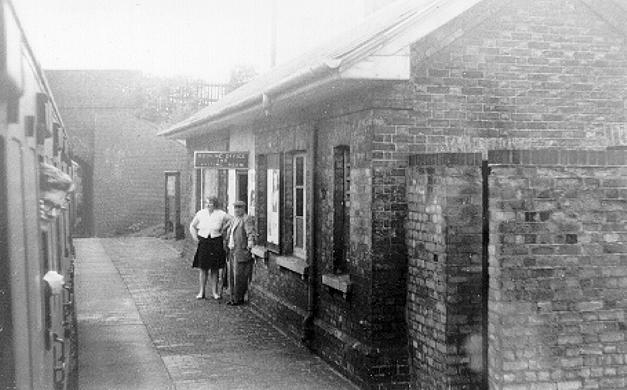
Great Linford railway station, May 1967
|
As with many rural lines, the development of road transport gradually began
to erode passenger numbers. The first motor bus service in the country was introduced between
Newport Pagnell and Olney in 1898 and the popularity of the motor car through the 20th century
eventually spelled the end for the line. The last passenger train ran on 7th September 1964,
now operated by British railways (London Midland Region). Goods traffic continued for three years
until final closure on 22nd May 1967. The track was lifted later the same year.
return to the top...
Moving cities and jobs with the railway
return to the top...
|
|
